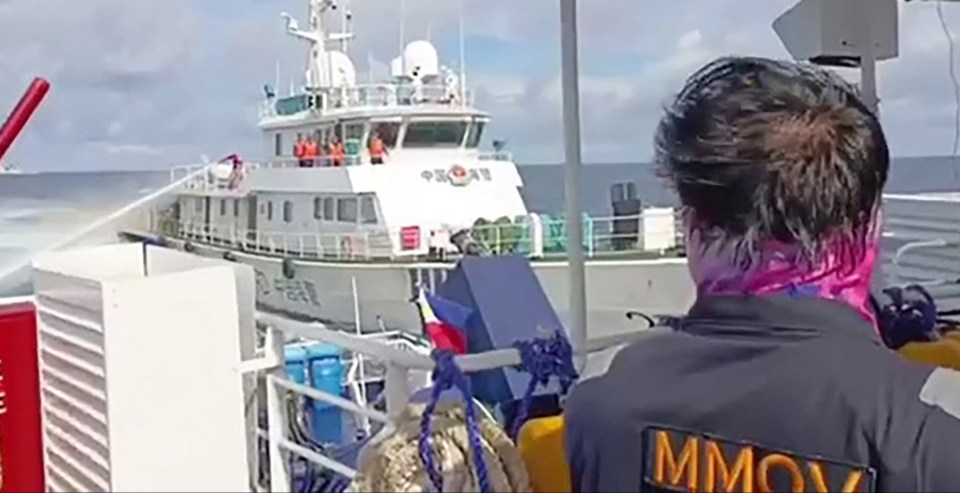A CHINESE ship “deliberately rammed” into a Philippine government vessel in a shocking clash in the South China Sea.
Dramatic footage released by Manila showed the Chinese coast guard deploying its water cannon and chasing the Philippine vessel before the collision in a brazen show of force.
Video footage shows the Chinese coastguard ship deploying water cannonAFP
The ship deployed a water cannon before ramming into the Philippine boatAFP
AFPA China coastguard ship deploying water cannon at a Philippine Bureau of Fisheries vessel[/caption]
Manila’s coast guard said three vessels were anchored near the island on Sunday to protect local fishermen when Chinese ships approached and used water cannon to intimidate them.
An hour later, a Chinese coast guard ship “fired its water cannon” at one of the boats – before it “deliberately rammed the stern” of the same vessel just three minutes later.
It caused “minor structural damage but no injuries to the crew”, the Philippines coast guard said.
“Despite these bullying tactics and aggressive actions… we will not be intimidated or driven away,” a statement said.
They described it as a “clear threat” as tensions escalate in the hotly contested waterway.
But Beijing hit back and blamed the Philippines for the collision.
Chinese coast guard spokesperson Liu Dejun said the Philippine ship “ignored repeated stern warnings from the Chinese side, and “dangerously approached” the other ship.
He said Philippine government vessels “illegally entered” waters near Sandy Cay, a coral reef in the northern Thitu Reefs within the Spratly Islands, leading to a collision.
China has tried to claim the Spratly islands for years – and clashes between Philippine and Chinese vessels are common in the area.
Beijing claims the region almost entirely despite an international ruling that the assertion has no legal basis.
Manila’s authorities vowed to continue operations in the area – emphasising the need to protect Filipino fishermen’s livelihood.
Tensions have heightened recently, particularly over the Scarborough Shoal and other contested regions in the South China Sea, which China claims almost entirely.
Brunei, Indonesia, Malaysia, the Philippines, and Vietnam also assert claims over portions of the waterway – a strategic trade route that facilitates over $3trillion in annual ship-borne commerce.
More than 60 per cent of global maritime trade passes through the disputed waterway.
In August, a Chinese navy warship crashed into its own coast guard vessel while chasing a Philippine patrol boat in South China Sea.
Dramatic footage released by Manila showed a massive Chinese warship bearing the number 164 on its hull smashing into a China Coast Guard ship with a loud crash.
The Chinese ship sustained major damage to its hull after crashing into its own coast guard ship.
The Philippine coast guard was escorting boats distributing aid to fishermen in the area when the Chinese navy vessels began chasing them.
Why is the South China Sea contested?
THE South China Sea is an arena for a power struggle between different powers.
Several countries claim the rights to large portions of its territory based on historical rights.
The problem is, some of these claims overlap.
China’s claim is based on a vague “nine-dash line” on some maps, which is not generally recognised in international law.
Many countries argue that China’s claims violate the United Nations Convention on the Law of the Sea (UNCLOS).
Other countries, like Vietnam, the Philippines, Malaysia and Brunei, are eager not the concede the territory, because it is known to hold valuable natural assets like natural resources.
One major point of tension is the Spratly Islands, with multiple countries claiming ownership of various islets and reefs.
China has been criticized for constructing artificial islands in the South China Sea and deploying military equipment there.
Recent announcements for a seabed research centre will further inflame this anger.

